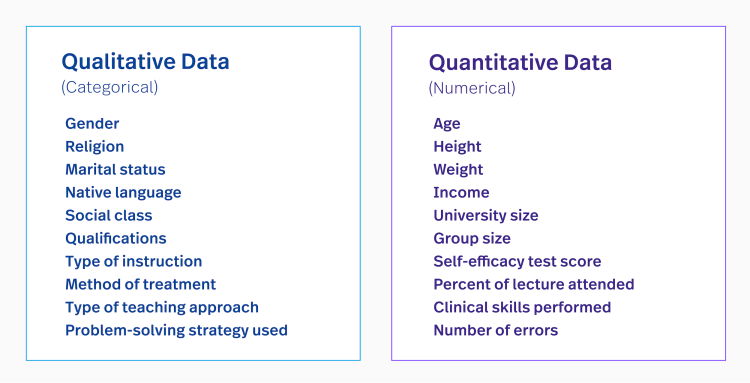If you're reading this, you likely already know the importance of data analysis. And you already know it can be incredibly complex.
At its simplest, research and its data can be divided into two categories: quantitative and qualitative. But what's the difference between each? When should you use them? And how can you use them together?
Understanding the differences between qualitative and quantitative data is key to any research project. Knowing both approaches can help you better understand your data and, ultimately, your customers.
Quick takeaways:
Quantitative research uses objective, numerical data to answer questions like "what" and "how often." Conversely, qualitative research seeks to answer questions like "why" and "how," focusing on subjective experiences to understand motivations and reasons.
Quantitative data is collected through methods like surveys and experiments and analyzed statistically to identify patterns. Qualitative data is gathered through interviews or observations and analyzed by categorizing information to understand themes and insights.
Are you making the most of your data?
Take our data maturity quiz to see where your brand stands and access strategies to enhance your approach.
What is quantitative data?
Qualitative and quantitative data differ in their approach and the type of data they collect.
Quantitative data refers to any information that can be quantified — that is, numbers. If it can be counted or measured, and given a numerical value, it's quantitative in nature. Think of it as a measuring stick.
Quantitative variables can tell you "how many," "how much," or "how often."
Some examples of quantitative data:
How many people attended last week's webinar?
How much revenue did our company make last year?
How often does a customer rage click on this app?
Which area of a webpage receives the most engagement, as shown by heatmaps?
To analyze these research questions and make sense of this quantitative data, you’d normally use a form of statistical analysis—collecting, evaluating, and presenting large amounts of data to discover patterns and trends. Quantitative data is conducive to this type of analysis because it’s numeric and easier to analyze mathematically.
Computers now rule statistical analytics, even though traditional methods have been used for years. But today’s data volumes make statistics more valuable and useful than ever. When you think of statistical analysis now, you think of powerful computers and algorithms that fuel many of the software tools you use today.
Popular quantitative data collection methods are surveys, experiments, polls, and more.
Tools like user session replay software provide granular visibility into user interactions, adding depth to quantitative data by showing exactly how users engage with site elements.
Quantitative Data 101: What is quantitative data?
Take a deeper dive into what quantitative data is, how it works, how to analyze it, collect it, use it, and more.
What is qualitative data?
Unlike quantitative data, qualitative data is descriptive, expressed in terms of language rather than numerical values.
Qualitative data analysis describes information and cannot be measured or counted. It refers to the words or labels used to describe certain characteristics or traits.
You would turn to qualitative data to answer the "why?" or "how?" questions. It is often used to investigate open-ended studies, allowing participants (or customers) to show their true feelings and actions without guidance.
Some examples of qualitative data:
Why do people prefer using one product over another?
How do customers feel about their customer service experience?
What do people think about a new feature in the app?
Think of qualitative data as the type of data you'd get if you were to ask someone why they did something. Popular data collection methods are in-depth interviews, focus groups, or observation.
Start growing with data and Fullstory.
Request your personalized demo of the Fullstory behavioral data platform.
What are the differences between qualitative vs. quantitative data?
When it comes to conducting data research, you’ll need different collection, hypotheses and analysis methods, so it’s important to understand the key differences between quantitative and qualitative data:
Quantitative data is numbers-based, countable, or measurable. Qualitative data is interpretation-based, descriptive, and relating to language.
Quantitative data tells us how many, how much, or how often in calculations. Qualitative data can help us to understand why, how, or what happened behind certain behaviors.
Quantitative data is fixed and universal. Qualitative data is subjective and unique.
Quantitative research methods are measuring and counting. Qualitative research methods are interviewing and observing.
Quantitative data is analyzed using statistical analysis. Qualitative data is analyzed by grouping the data into categories and themes.
As you can see, both provide immense value for any data collection and are key to truly finding answers and patterns.
More examples of quantitative and qualitative data
You’ve most likely run into quantitative and qualitative data today, alone. For the visual learner, here are some examples of both quantitative and qualitative data:
Quantitative data example
The customer has clicked on the button 13 times.
The engineer has resolved 34 support tickets today.
The team has completed 7 upgrades this month.
14 cartons of eggs were purchased this month.
Qualitative data example
My manager has curly brown hair and blue eyes.
My coworker is funny, loud, and a good listener.
The customer has a very friendly face and a contagious laugh.
The eggs were delicious.
The fundamental difference is that one type of data answers primal basics and one answers descriptively.
What does this mean for data quality and analysis? If you just analyzed quantitative data, you’d be missing core reasons behind what makes a data collection meaningful. You need both in order to truly learn from data—and truly learn from your customers.
Addressing bias in data collection and analysis
While both quantitative and qualitative data provide valuable insights, it's important to recognize that both are susceptible to bias. Understanding and mitigating these biases is crucial for conducting reliable research and drawing accurate conclusions.
In quantitative research, selection bias is a common concern. This occurs when the data collected isn't truly representative of the population being studied, potentially leading to skewed results. For instance, an online-only survey might exclude demographics with limited internet access.
Qualitative research faces its own bias challenges. Researcher bias can influence data interpretation, while participant selection bias might result in missing important perspectives. Additionally, participants might alter their responses based on what they think the researcher wants to hear.
To address these issues:
Use careful sampling methods in quantitative studies
Employ strategies like triangulation and reflexivity in qualitative research
Consider mixed methods approaches when possible
Be transparent about potential limitations in your research
By acknowledging and actively working to minimize bias in both quantitative and qualitative research, researchers can enhance the validity and reliability of their findings, leading to more accurate and useful insights.
What are the advantages and disadvantages of each?
Both types of data has their own pros and cons.
Advantages of quantitative data
It’s relatively quick and easy to collect and it’s easier to draw conclusions from.
When you collect quantitative data, the type of results will tell you which statistical tests are appropriate to use.
As a result, interpreting your data and presenting those findings is straightforward and less open to error and subjectivity.
Another advantage is that you can replicate it. Replicating a study is possible because your data collection is measurable and tangible for further applications.
Disadvantages of quantitative data
Quantitative data doesn’t always tell you the full story (no matter what the perspective).
With choppy information, it can be inconclusive.
Quantitative research can be limited, which can lead to overlooking broader themes and relationships.
By focusing solely on numbers, there is a risk of missing larger focus information that can be beneficial.
Advantages of qualitative data
Qualitative data offers rich, in-depth insights and allows you to explore context.
It’s great for exploratory purposes.
Qualitative research delivers a predictive element for continuous data.
Disadvantages of qualitative data
It’s not a statistically representative form of data collection because it relies upon the experience of the host (who can lose data).
It can also require multiple data sessions, which can lead to misleading conclusions.
The takeaway is that it’s tough to conduct a successful data analysis without both. They both have their advantages and disadvantages and, in a way, they complement each other.
Now, of course, in order to analyze both types of data, information has to be collected first.
Let's get into the research.
Quantitative and qualitative research
The core difference between qualitative and quantitative research lies in their focus and methods of data collection and analysis. This distinction guides researchers in choosing an appropriate approach based on their specific research needs.
For example, A/B testing can complement both approaches by allowing teams to test quantitative outcomes of different variants while gathering qualitative insights from user feedback on why certain variations perform better.
Best practices of each help to look at the information under a broader lens to get a unique perspective. Using both methods is helpful because they collect rich and reliable data, which can be further tested and replicated.
What is quantitative research?
Quantitative research is based on the collection and interpretation of numeric data. It's all about the numbers and focuses on measuring (using inferential statistics) and generalizing results. Quantitative research seeks to collect numerical data that can be transformed into usable statistics.
It relies on measurable data to formulate facts and uncover patterns in research. By employing statistical methods to analyze the data, it provides a broad overview that can be generalized to larger populations.
Behavioral data refers to everything in terms of numbers (or discrete data)—like the number of users clicking a button, bounce rates, time on site, and more.
Some examples of quantitative research:
What is the amount of money invested into this service?
What is the average number of times a button was dead clicked?
How many customers are actually clicking this button?
Essentially, quantitative research is an easy way to see what’s going on at a 20,000-foot view.
Each data set (or customer action, if we’re still talking digital experience) has a numerical value associated with it and is quantifiable information that can be used for calculating statistical analysis so that decisions can be made.
You can use statistical operations to discover feedback patterns (with any representative sample size) in the data under examination. The results can be used to make predictions, find averages, test causes and effects, and generalize results to larger measurable data pools.
Unlike qualitative methodology, quantitative research offers more objective findings as they are based on more reliable numeric data.
Quantitative data collection methods
Surveys
A survey is one of the most common research methods with quantitative data that involves questioning a large group of people. Questions are usually closed-ended and are the same for all participants. An unclear questionnaire can lead to distorted research outcomes.
Polls
Similar to surveys, polls yield quantitative data. That is, you poll a number of people and apply a numeric value to how many people responded with each answer.
Experiments
An experiment is another common method that usually involves a control group and an experimental group. The experiment is controlled and the conditions can be manipulated accordingly. You can examine any type of records involved if they pertain to the experiment, so the data is extensive.
What is qualitative research?
Qualitative research does not simply help to collect data. It gives a chance to understand the trends and meanings of natural actions. It’s flexible and iterative.
Qualitative research focuses on the qualities of users—the actions that drive the numbers. It's descriptive research. The qualitative approach is subjective, too.
It focuses on describing an action, rather than measuring it.
Some examples of qualitative research:
The sunflowers had a fresh smell that filled the office.
All the bagels with bites taken out of them had cream cheese.
The man had blonde hair with a blue hat.
Qualitative research utilizes interviews, focus groups, and observations to gather in-depth insights.
This approach shines when the research objective calls for exploring ideas or uncovering deep insights rather than quantifying elements.
Qualitative data collection methods
Interviews
An interview is the most common qualitative research method. This method involves personal interaction (either in real life or virtually) with a participant. It’s mostly used for exploring attitudes and opinions regarding certain issues.
Interviews are very popular methods for collecting data in product design.
Focus groups
Data analysis by focus group is another method where participants are guided by a host to collect data. Within a group (either in person or online), each member shares their opinion and experiences on a specific topic, allowing researchers to gather perspectives and deepen their understanding of the subject matter.
Digital Leadership Webinar: Accelerating Growth with Quantitative Data and Analytics
Learn how the best-of-the-best are connecting quantitative data and experience to accelerate growth.
So which type of data is better for data analysis?
So how do you determine which type is better for data analysis?
Quantitative data is structured and accountable. This type of data is formatted in a way so it can be organized, arranged, and searchable. Think about this data as numbers and values found in spreadsheets—after all, you would trust an Excel formula.
Qualitative data is considered unstructured. This type of data is formatted (and known for) being subjective, individualized, and personalized. Anything goes. Because of this, qualitative data is inferior if it’s the only data in the study. However, it’s still valuable.
Because quantitative data is more concrete, it’s generally preferred for data analysis. Numbers don’t lie. But for complete statistical analysis, using both qualitative and quantitative yields the best results.
At Fullstory, we understand the importance of data, which is why we created a behavioral data platform that analyzes customer data for better insights. Our platform delivers a complete, retroactive view of how people interact with your site or app—and analyzes every point of user interaction so you can scale.
Unlock business-critical data with Fullstory
A perfect digital customer experience is often the difference between company growth and failure. And the first step toward building that experience is quantifying who your customers are, what they want, and how to provide them what they need.
Access to product analytics is the most efficient and reliable way to collect valuable quantitative data about funnel analysis, customer journey maps, user segments, and more.
But creating a perfect digital experience means you need organized and digestible quantitative data—but also access to qualitative data. Understanding the why is just as important as the what itself.
Fullstory's DXI platform combines the quantitative insights of product analytics with picture-perfect session replay for complete context that helps you answer questions, understand issues, and uncover customer opportunities.
Start a free 14-day trial to see how Fullstory can help you combine your most invaluable quantitative and qualitative insights and eliminate blind spots.




